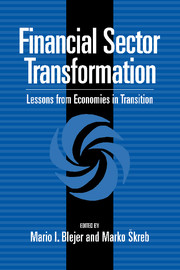Book contents
- Frontmatter
- Contents
- List of Contributors
- Introduction: Financial Reforms and Economic Transition: An Overview of the Major Issues
- PART I GENERAL STUDIES
- 1 Monetary Policy during Transition: An Overview
- 2 Toward Market-Oriented Banking in the Economies in Transition
- 3 The Trials and Tribulations of Banking in Transition Economies: A Political Economy Perspective
- 4 Financing Transition: Investing in Enterprises during Macroeconomic Transition
- PART II COUNTRY STUDIES
- PART III AFTERWORD
- Index
1 - Monetary Policy during Transition: An Overview
Published online by Cambridge University Press: 05 November 2011
- Frontmatter
- Contents
- List of Contributors
- Introduction: Financial Reforms and Economic Transition: An Overview of the Major Issues
- PART I GENERAL STUDIES
- 1 Monetary Policy during Transition: An Overview
- 2 Toward Market-Oriented Banking in the Economies in Transition
- 3 The Trials and Tribulations of Banking in Transition Economies: A Political Economy Perspective
- 4 Financing Transition: Investing in Enterprises during Macroeconomic Transition
- PART II COUNTRY STUDIES
- PART III AFTERWORD
- Index
Summary
This chapter looks at monetary policy in twenty-six transition countries in Europe and Central Asia from 1989 to 1995. The purpose is to provide a broad characterization of the experience of these countries as they make the transition from a socialist economy, where money and credit were largely determined as a residual, to a market economy, where monetary policy plays an active role in economic management and where economic efficiency is believed to be enhanced by the variety and sophistication of financial instruments. In the process, we classify countries by the extent of market orientation in the use of monetary policy instruments, by indicators of policy stance, and by broad measures of effectiveness. The relationships between these three dimensions are evaluated by cross-country comparison over the transition period and at the time of stabilization.
To place the discussion in context, the first section reviews briefly the nature of money and finance under socialism and provides a snapshot of various financial development ratios at the beginning of transition. The second section discusses countries' policy response to transition and distinguishes two groups – one where a monetary policy framework was quickly developed as part of the economic transformation strategy and another where continued participation in the ruble zone and greater ambivalence toward reform resulted in delayed stabilization programs.
In the third section, we look at how monetary policy has been conducted. The focus is on the use of specific policy instruments, for which we identify “late socialism,’ “transitional,” and “market-oriented” forms. We then classify countries by the extent of market orientation in their use of both direct and indirect instruments.
- Type
- Chapter
- Information
- Financial Sector TransformationLessons from Economies in Transition, pp. 19 - 92Publisher: Cambridge University PressPrint publication year: 1999
- 1
- Cited by



